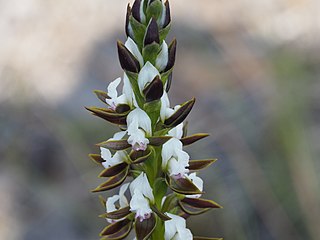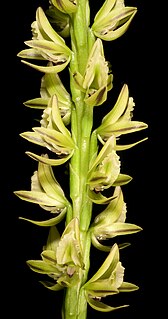
Prasophyllum sargentii, commonly known as the frilled leek orchid, is a species of orchid endemic to the south-west of Western Australia. It is a tall orchid with a single smooth, tubular leaf and up to thirty or more purplish and white or golden brown and white flowers with a frilled labellum.

Prasophyllum fimbria, commonly known as the fringed leek orchid, is a species of orchid endemic to the south-west of Western Australia. It is a tall orchid with a single smooth, tube-shaped leaf and up to seventy greenish-brown flowers with a white and pink labellum.

Genoplesium nigricans, commonly known as mallee midge orchid, is a species of orchid endemic to a Australia. It is a terrestrial herb with a single leaf mostly surrounding the stem, and up to 50 tiny, greenish flowers with a deep maroon-coloured labellum and often have a fruity fragrance. Australian authorities use the name Corunastylis tepperi, a widespread species which has been confused with Corunastylis nigricans, a species with purplish brown flowers and which only occurs on Kangaroo Island and the Eyre Peninsula.

Prasophyllum brownii, commonly known as the Christmas leek orchid, is a species of orchid endemic to the south-west of Western Australia. It is one of the last of the genus in Western Australia to flower and has a tall flowering stem with up to eighty pale green and fawn-coloured flowers.
Prasophyllum cucullatum, commonly known as the hooded leek orchid, is a species of orchid endemic to the south-west of Western Australia. It is a tall orchid with a single smooth, tubular leaf and up to fifty or more purplish-red and white flowers with a frilled labellum crowded along a relatively short flowering stem.

Prasophyllum cyphochilum, commonly known as the pouched leek orchid, is a species of orchid endemic to the south-west of Western Australia. It is a relatively common orchid with a single smooth, tubular leaf and up to thirty or more pale yellow and brown flowers. The flowers do not open fully, are more or less cup-shaped and have a "humped" labellum.
Prasophyllum drummondii, commonly known as the swamp leek orchid, is a species of orchid endemic to the south-west of Western Australia. It is a late-flowering species with a single tubular leaf and up to thirty brownish-orange or pale yellow flowers and often grows in standing water.
Prasophyllum favonium, commonly known as the western leek orchid, is a species of orchid endemic to Tasmania. It has a single tubular leaf with a reddish base and between five and fifteen brownish flowers with a dark purple labellum. In 2000, the entire population was estimated to be less than forty mature plants in a very small area.
Prasophyllum fecundum, commonly known as the self-pollinating leek orchid, is a species of orchid endemic to South Australia. It has a single, smooth, tube-shaped leaf with a reddish or purplish base, and up to twelve relatively small green and purplish flowers. The flowers are short-lived and self-pollinating although attractive to insects.
Prasophyllum gibbosum, commonly known as the humped leek orchid, is a species of orchid endemic to the south-west of Western Australia. It is a late-flowering leek orchid with a single smooth, tubular leaf and up to eighty or more purplish-red and white flowers with a smooth labellum. It is similar to P. cucullatum but that species has a frilly labellum, usually a shorter flowering stem and an earlier flowering period.
Prasophyllum giganteum, commonly known as the bronze leek orchid, is a species of orchid endemic to the south-west of Western Australia. It is a tall, fragrant leek orchid with a single smooth, tubular leaf and up to fifty or more green and pinkish-purple flowers with a frilly labellum.
Prasophyllum macrostachyum, commonly known as the laughing leek orchid, is a species of orchid endemic to the south-west of Western Australia. It has a single smooth, tube-shaped leaf and up to thirty yellowish-green and purple flowers. It is one of the few Western Australian leek orchids which is not stimulated by summer fires and also has an unusually long flowering period.
Prasophyllum macrotys, commonly known as the inland leek orchid, is a species of orchid endemic to the south-west of Western Australia. It has a single tubular leaf and up to thirty greenish to purplish flowers and is similar to the tall leek orchid but has smaller, darker flowers.
Prasophyllum ovale, commonly known as the little leek orchid, is a species of orchid endemic to the south-west of Western Australia. It is a small leek orchid with a single smooth, tubular leaf and up to twenty or more white, green and brown flowers with the labellum only slightly upturned.
Prasophyllum paulinae, commonly known as Pauline's leek orchid, is a species of orchid endemic to the south-west of Western Australia. It is a small, rare leek orchid with a single smooth, tubular leaf and up to seventy yellowish-green and purple flowers.
Prasophyllum plumiforme, commonly known as the dainty leek orchid, is a species of orchid endemic to the south-west of Western Australia. It is a small leek orchid with a single smooth, tubular leaf and up to fifty or more tiny cream-coloured or greenish-yellow flowers on a tall flowering stem.
Prasophyllum regium, commonly known as the king leek orchid, is a species of orchid endemic to the south-west of Western Australia. It has a single, unusually thick tubular leaf and up to one hundred relatively large, greenish-brown or burgundy-coloured flowers. It is one of the tallest leek orchids, sometimes growing to a height of 2 m (7 ft).

Prasophyllum tunbridgense, commonly known as the Tunbridge leek orchid, is a species of orchid endemic to Tasmania. It has a single tubular, bright green leaf and up to twenty five relatively large, green to light greenish-brown flowers with white petals and a large white labellum.
Prasophyllum atratum, commonly known as the Three Humock leek orchid, is a species of orchid endemic to Tasmania. It has a single tubular, dark green leaf and up to twenty five brownish- to purplish-green flowers with a dark purplish labellum. It is only known from a single population of fewer than one thousand plants growing on Three Hummock Island.
Prasophyllum mimulum, commonly known as the highland leek orchid, is a species of orchid endemic to Tasmania. It has a single tubular, green leaf and up to ten greenish-brown to purplish flowers with purple and white petals and a white labellum. It is restricted to subalpine areas of the state.


















